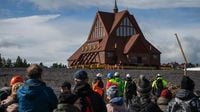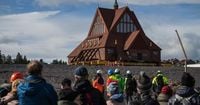In the far north of Sweden, a remarkable feat of engineering and community spirit unfolded this week as Kiruna Kyrka, a beloved wooden church and architectural icon, made its slow, carefully orchestrated journey across the city of Kiruna. On August 19, 2025, after eight years of meticulous planning and more than half a billion kronor (roughly $52 million USD) spent, the church began its two-day, five-kilometer trek—an event that drew crowds, sparked debate, and highlighted the profound changes underway in this Arctic mining town.
The reason for this extraordinary move? The relentless expansion of Europe’s largest underground iron ore mine, operated by the state-owned company LKAB, has been causing the ground beneath Kiruna to crack and sink. As the mine’s tunnels stretched deeper and wider, the very foundations of the city were threatened, putting roads, homes, and even its most cherished building at risk. According to The Guardian, nearly the entire town is being rebuilt at a safe distance from the mine, a process expected to last until 2035 and involve the relocation of almost 6,000 residents and a third of Kiruna’s buildings.
Kiruna Kyrka, inaugurated in 1912 and designed by architect Gustaf Wickman, is often described as “the largest wooden building in Sweden.” Its distinctive red timber exterior, sharp peaks, and triangular forms have long dominated the local skyline, earning it the title of Sweden’s most beautiful building. “It’s like you’re going into a boat. That’s the same feeling. But it’s a very big boat,” Vicar Lena Tjärnberg told NPR, reflecting on the church’s unique atmosphere and the emotional weight of the move.
The effort to save the church from destruction was nothing short of monumental. Engineers dug out its foundation and slid bright yellow beams underneath, creating a stable platform. The entire 672-tonne structure was then gently lifted onto two trucks, each equipped with a staggering 130 wheels. With two engineers stationed inside to listen for any telltale cracks, the convoy inched forward at just half a kilometer per hour, navigating newly widened streets—expanded from 9 to 24 meters to accommodate the church’s bulk—while onlookers lined the route, snapping photos and cheering the progress. Traditional Swedish fika breaks punctuated the labor, adding a touch of local flavor to the historic occasion.
For many in Kiruna, the church is far more than just a building. “They have grown up in the church, they have played out in the park around the church. They have been like a home for people, and I think that’s Kiruna’s soul in some way,” said Tjärnberg. The church’s role as a community anchor made demolition unthinkable. “Tearing down the church to build a new one just wasn’t an option because of its significance to the community,” she explained to NPR.
Yet, the move was not without its complications and controversies. As reported by the South China Morning Post, some members of the Indigenous Sámi community viewed the high-profile relocation as a distraction from deeper, unresolved losses. “It feels rather difficult to see the move of the church when I’m well aware of the consequences that mining activities have on everything around it,” said Karin K Niia, a reindeer owner and board member of Gabna Sameby. She called the relocation “a big show” that preserves a symbol while ignoring the damage to biodiversity, water, and the Sámi culture rooted in the region’s land.
LKAB, for its part, has acknowledged the strain the mining operation has placed on both the environment and the community. “The move of Kiruna church is necessary for it to continue to exist at all. We are obliged to compensate for what is affected by the mine,” said Stefan Hämäläinen, LKAB’s senior vice president of urban development. The company has offered residents the choice to have their homes rebuilt or to receive financial compensation as part of the massive urban transformation. “If the mine is to remain, we have to move Kiruna city centre,” LKAB’s chief executive Jan Moström stated during a live broadcast. “Kiruna city centre without the church, I can’t see it—so there are no alternatives.”
Amid the logistical challenges and emotional farewells, the church’s journey became a community event. On August 20, as the building arrived at its new home in the city’s relocated center, residents gathered for a special service and attempted a world record for “church coffee”—a beloved Swedish tradition—accompanied by music from singer Carola. The move was not just about saving a structure, but about preserving a sense of continuity and identity as the town itself is rebuilt around new foundations.
For Vicar Tjärnberg, the experience was bittersweet. “I’m a little worried about the church too. It’s going to feel different when I open the church door and it’s not in the same place because we have loved this place,” she admitted. “It’s like the skyline of Kiruna. Everywhere you’re in Kiruna, you can see the church. Or you saw the church because it’s on the move now.” She recalled how, for nine years, she greeted the church from her kitchen window each morning and night, only to return home now to the sight of a construction site. Still, she remains optimistic: “Every change, you can do something good with it. We are going to do something good.”
The relocation of Kiruna Kyrka stands as a symbol of both loss and resilience—a testament to the lengths a community will go to protect its heritage, even as the ground beneath it shifts. The church is expected to reopen at its new location by the end of 2026, with hopes high that its spirit will endure, even if its view has changed forever.


